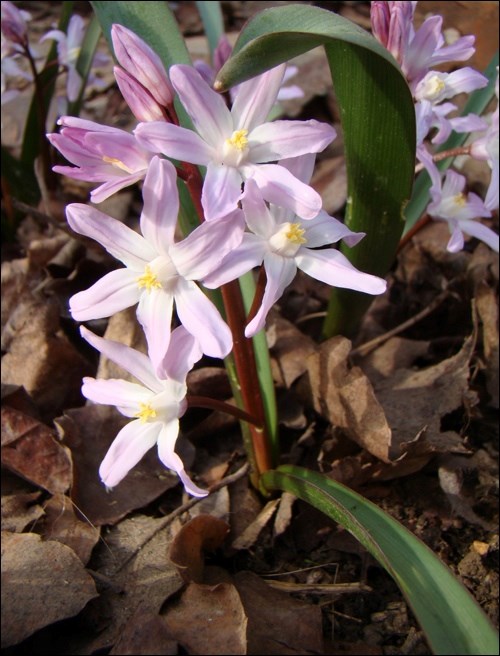While most of us are familiar with the well-marketed and visually larger tulips and lilies, there are other bulbs — a group that is collectively referred to as “minor bulbs.”
These are the small ones: glory of the snow, grape hyacinth, striped squill and Siberian squill. They are called minor bulbs because both the bulbs and the plants that develop from them are small in size and perhaps because they make up a very minor part of the international bulb trade. But small is good. They are a standout in prairie gardens and should be planted much more frequently than they are.
And with small, location is important. They can tolerate full to part sun and be used in at the front of a border, in rock gardens or for naturalizing below trees and shrubs.
All require good drainage – they will simply rot if placed where water sits. And best of all, given the right location, they will last for a long time, requiring only division every four years or so. They are generally purchased and planted in the fall for bloom the following season.
Glory of the snow (Chionodoxa forbesii, syn. C. luciliae)
These are among the first of the minor bulbs to bloom in the spring, sometimes while there is still snow on the ground, thus their common name. The botanical name, from the Greek words chion (snow) and doxa (glory), mimics the common name and alludes to the early blooms.
These are very small plants (15 cm/6 in.) starry lavender-blue, white or pink flowers with six petals, yellow anthers and a white centre. The two leaves are green and grass-like. They are not loved for their individual flowers but for their collective effect en mass, which seems to appear overnight like a carpet. ‘Rosea’ is pink; ‘Pink Giant’ is 10 cm (4 in.).
Grape hyacinth (Muscari spp.)
Here is another dependable minor bulb that forms a colony that increases from year to year. The botanical name is from the Greek word for musk and describes their scent.
Blooming in early spring, the flowers of grape hyacinths resemble a miniature pyramid of blue-purple grapes sitting on a stalk above grassy foliage, thus the derivation of the common name. Three species are generally offered.
M. armeniacum, from southeastern Europe and the Caucuses, is probably the hardiest species. It has dark blue flowers and is 30 cm (12 in.) high. ‘Album’ is white form of this species.
M. azureum, from Turkey, is a little shorter at 20 cm (8 in.) with sky-blue flowers. ‘Album’ is a white form of this species.
M. latifolium, from southwest Asia, is striking and unusual in that it has dark blue flowers at the bottom and paler, sterile flowers (sometimes oddly shaped) above and only one, albeit wide, leaf. It may be less hardy but is worth trying in a sheltered location.
Puschkinia, Lebanon squill (Puschkinia scilloides syn. P. libanotica)
Unless you’re close up and on your knees, these tiny flowers are such a pale blue (with a darker blue line down the middle of each petal) that they appear almost white. They were named after a Russian chemist and botanist, Count Mussim-Puschkin, who collected them. Only 15 cm (6 in.) in height, with two to three narrow leaves, they are another carpeting type of bulb and will gradually form a colony.
‘Alba’ is a white form.
Siberian squill (Scilla siberica)
These small bulbs have naturalized in my lawn of their own volition. The genus name is from the Greek skilla, meaning sea-squill, an old-fashioned houseplant to which Scilla is related.
Sometimes called bluebell, they are one of the earliest harbingers of spring, producing blue, down-facing flowers in May above grassy, 15 cm (6 in.) foliage. Given moderately favourable conditions, they soon colonize through reseeding. ‘Alba’ is a white form; ‘Spring Beauty’ is darker blue selection, taller and more robust; S. var. taurica is a more intense blue.
Sara Williams is the author of the newly expanded and revised Creating the Prairie Xeriscape; Gardening, Naturally: A chemical-free handbook for the Prairies; and the Saskatoon Forestry Farm Park & Zoo: A Photographic History. Sara will be leading a garden tour to Great Britain in May, 2016 and co-leading, with Melanie Elliot, a tour of Fauna and Flora of Iceland in July, 2016. Call Ruth (1-888-778-2378) for more information.
— This column is provided courtesy of the Saskatchewan Perennial Society (www.saskperennial.ca; hortscene@yahoo.com). Check out our Bulletin Board or Calendar for upcoming garden information sessions, workshops and tours: Oct 21, Lyndon Penner’s Favourite Perennials.



